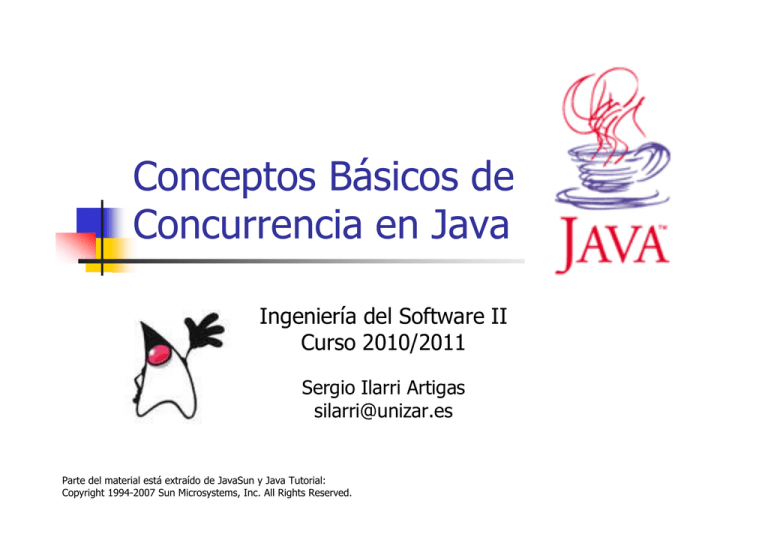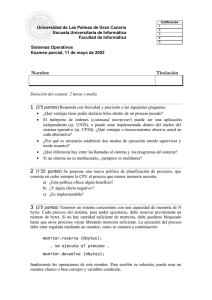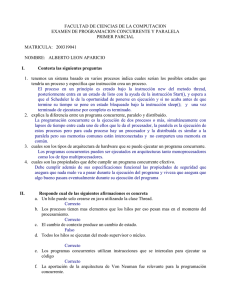Basic Concepts of Concurrency in Java
Anuncio

Conceptos Básicos de C Concurrencia i en Java Ingeniería del Software II Curso 2010/2011 Sergio Ilarri Artigas [email protected] Parte del material está extraído de JavaSun y Java Tutorial: Copyright 1994-2007 Sun Microsystems, Inc. All Rights Reserved. Índice Detallado Programación Concurrente Concepto de Thread Crear y Arrancar Threads Control de Threads: stop, suspend/resume, sleep, join, etc. etc Planificación de Threads Sincronización Otros Concepto de Thread CPU virtual Varias tareas al mismo tiempo Clase Thread (java.lang java lang) Creación: Clase A que implementa el interface Runnable Construir una instancia de Thread usando A Llama a start Llamar sta t(), () sólo 1 vez e Crear y Arrancar Threads (I) public interface Runnable { abstract b public bli void id run(); () } Cualquier objeto puede convertirse en thread No argumentos, no excepciones, no valor de retorno vida del thread retorno, class Animation implements Runnable { ... } Animation happy = new Animation("Mr. Happy"); Th Thread d myThread Th d = new Th Thread(happy); d(h ) myThread.start(); Crear y Arrancar Threads (II) O arrancando en el constructor class Animation implements Runnable { Thread myThread; Animation (String name) { myThread Th d = new Thread(this); Th d(thi ) myThread.start(); } } ... Control de Threads (I) stop() método complementario de start() destruye el thread deprecated (Java 1.2) suspend d(), () resume() pausa y reanuda el thread p ¡Deprecated! Utilizar en su lugar Object.wait y Object.notify Control de Threads (II) sleep(long millis) join() espera a que termine el thread isAlive() Planificación de Threads (I) Si sólo hay una CPU, sólo se ejecuta 1 thread cada vez Llamar a start() pone al thread en estado ejecutable, no lo ejecuta Los threads son normalmente p pero p no se asegura g un interrumpibles reparto por tiempo (no time-slicing) setPriority(…) ( ) Planificación de Threads (II) Por tanto, hay que llamar a sleep() de vez en cuando No necesariamente se reanuda el thread al terminar el período try {Thread.sleep(1000);} catch (InterruptedException e){…} El método yield() –pausa temporal- da paso a otros threads de igual prioridad Ciclo de Vida Otra Forma de Crear Threads class MyThread extends Thread { … public void run() { … } } MyThread t = new MyThread(); t start(); t.start(); Timer (en java.util java util): Ejecuta una TimerTask (implementa Runnable) tras un retardo Resumiendo: Dos Métodos de Creación de Threads public class HelloRunnable implements Runnable { } public class HelloThread extends Thread { public void run() { y p ( from a thread!"); ); System.out.println("Hello } public void run() { y p ( from a thread!"); ); System.out.println("Hello } public static void main(String args[]) { (new Thread(new HelloRunnable())).start(); } public static void main(String args[]) { ( (new HelloThread()).start(); ll h d()) () } } http://java.sun.com/docs/books/tutorial/essential/concurrency/runthread.html Ejemplo: SleepMessages public class SleepMessages { public static void main(String args[]) throws InterruptedException { String importantInfo[] = { "Mares eat oats", "Does eat oats", "Little lambs eat ivy", "A kid will eat ivy too" }; for (int i = 0; i < importantInfo.length; importantInfo length; i++) { //Pause for 4 seconds Thread.sleep(4000); //Print a message System.out.println(importantInfo[i]); } } } http://java.sun.com/docs/books/tutorial/essential/concurrency/sleep.html Ejemplo: SimpleThreads public class SimpleThreads { //Display a message, preceded by the name of the current thread static void threadMessage(String message) { String threadName = Thread.currentThread().getName(); Thread currentThread() getName(); System.out.format("%s: %s%n", threadName, message); } private static class MessageLoop implements Runnable { public void run() p () { String importantInfo[] = { "Mares eat oats", "Does eat oats", "Little lambs eat ivy", "A kid will eat ivy too" }; try { for (int i = 0; i < importantInfo.length; i++) { //Pause for 4 seconds Thread.sleep(4000); //Print a message threadMessage(importantInfo[i]); } } catch (InterruptedException e) { threadMessage("I wasn't done!"); } } } … http://java.sun.com/docs/books/tutorial/essential/concurrency/simple.html Ejemplo: SimpleThreads … public static void main(String args[]) throws InterruptedException { //Delay, in milliseconds before we interrupt MessageLoop //thread (default one hour). long patience = 1000 * 60 * 60; //If command line argument present, gives patience in seconds. if (args.length > 0) { try { patience i = Long.parseLong(args[0]) ( [0]) * 1000; 000 } catch (NumberFormatException e) { System.err.println("Argument must be an integer."); System.exit(1); } } … http://java.sun.com/docs/books/tutorial/essential/concurrency/simple.html Ejemplo: SimpleThreads … threadMessage("Starting MessageLoop thread"); long startTime = System.currentTimeMillis(); Thread t = new Thread(new MessageLoop()); t.start(); threadMessage("Waiting for MessageLoop thread to finish"); //loop until MessageLoop thread exits while (t.isAlive()) { threadMessage("Still waiting..."); //Wait maximum of 1 second for MessageLoop thread to //finish. t join(1000); t.join(1000); if (((System.currentTimeMillis() - startTime) > patience) && t.isAlive()) { threadMessage("Tired of waiting!"); t.interrupt(); //Sh ld 't b //Shouldn't be long l now -- wait it indefinitely i d fi it l t.join(); } } threadMessage("Finally!"); } } http://java.sun.com/docs/books/tutorial/essential/concurrency/simple.html Problemas de Concurrencia public class MyStack { int index=0; index 0; char[] data=new char[10]; public void p p push(char ( c) ) { data[index]=c; index++; } public char pop() { index--; return data[index]; } } ¡¡PROBLEMA!! Sincronización: Uso de Cerrojos Cada objeto en Java tiene un lock (cerrojo) asociado La palabra clave synchronized permite el acceso al lock: Espera en un pool por el cerrojo synchronized(objeto) { // Aquí se dispone ya del cerrojo … } Se libera de nuevo el cerrojo Ejemplo de Uso public void sampleMethod { synchronized(this) h i d( hi ) { … } } public synchronized void sampleMethod { … } Métodos notify y wait (Object) wait(): notify(): libera cerrojo hasta que alguien avise (con notifyy o notifyAll y ) y entonces lo retoma d despierta i t a 1 arbit. bit esperando d en ell cerrojo j notifyAll y () (): despierta a todos sólo 1 conseguirá el cerrojo Para llamarlos, hay que estar en posesión del cerrojo Ejemplo j p de Uso de Wait y Notify Espera activa public void guardedJoy() { //Simple loop guard. Wastes processor time. Don't do this! while(!joy) {} System.out.println("Joy has been achieved!"); } http://java.sun.com/docs/books/tutorial/essential/concurrency/guardmeth.html Ejemplo j p de Uso de Wait y Notify Espera “inteligente” public synchronized guardedJoy() { //This guard only loops once for each special event, which may not //be the event we're waiting for. while (!joy) { t { try wait(); } catch (InterruptedException e) {} } System.out.println("Joy and efficiency have been achieved!"); } public synchronized notifyJoy() { joy = true; notifyAll(); } http://java.sun.com/docs/books/tutorial/essential/concurrency/guardmeth.html Otros Métodos de Interés Variantes de wait(): wait(long millis) wait(long millis, millis int nanos) Deadlocks Un thread A espera la liberación de un lock por parte de otro thread B que a su vez espera la liberación de un lock mantenido por A E responsabilidad Es bilid d del d l programador d Obtener siempre p los cerrojos j en el mismo orden y liberarlos en orden inverso Ejemplo de Deadlock public class Deadlock { static class Friend { private final String name; public Friend(String name) { this.name = name; } public String getName() { return this.name; } public synchronized void bow(Friend bower) { System.out.format("%s: %s has bowed to me!%n", this.name, bower.getName()); bower.bowBack(this); } … http://java.sun.com/docs/books/tutorial/essential/concurrency/deadlock.html Ejemplo de Deadlock … public synchronized void bowBack(Friend bower) { System.out.format("%s: %s has bowed back to me!%n", this.name, bower.getName()); } } public static void main(String[] args) { final Friend alphonse = new Friend("Alphonse"); final Friend gaston = new Friend("Gaston"); new Thread(new Runnable() { public void run() { alphonse.bow(gaston); } }).start(); new Thread(new Runnable() { public void run() { gaston.bow(alphonse); } }).start(); } } http://java.sun.com/docs/books/tutorial/essential/concurrency/deadlock.html Otros ThreadGroup activeCount getMaxPriority setMaxPriority resume stop suspend Referencias Concurrency in Java - Tutorial. http://java sun com/docs/books/tutorial/essential/con http://java.sun.com/docs/books/tutorial/essential/con currency/ Thread Programming Programming, Paul Hyde, Hyde Sams, Sams ISBN 0672315858, 528 pages. Thinking in Java, Java Bruce Eckel, Eckel Prentice Hall, Hall 4th edition, ISBN 0131002872. Thinking in Java, 3th edition. Free download: http://mindview.net/Books/TIJ/DownloadSites


